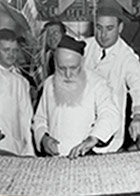Thoroughly Modern Matzah

When Jews the world over sit down next week to mark the birth of Jewish history, matzah will figure prominently at the table. Matzah baking is an exacting task; according to traditional law, the entire process, from first kneading to exit from the oven, must be accomplished in 18 minutes flat, with not a speck of leaven in sight. For thousands of years, these specifications and others were laboriously met by hand. Yet this most ancient food has a modern history, too.
The first matzah machine was invented in 1838 in France. With rabbinic approval, the technology moved steadily eastward. The first vigorous opposition arose in Galicia in the late 1850's, as questions about whether the technique met halakhic standards erupted into heated and often personal polemics. But the fight for and against did not always divide along predictable lines. Some moderate rabbis hoped that opposing the machines would help confirm their traditionalist bona fides, while some staunch traditionalists favored the machines precisely for their elimination of human error.
The socio-economic arguments cut both ways, too. To some, the machines harmed the unskilled laborers whose livelihood derived from matzah-baking. To others, the lower prices made possible by the machines eased the masses' economic burdens.
Meanwhile, in America, even those rabbis skeptical of machine matzot judged that they were better than nothing for the nation's many unlettered Jews. In 1888, Behr Manischewitz, an astute and pious immigrant from East Prussia, opened a matzah factory in Cincinnati. Soon facing local competition, he cut costs, improved quality, and burnished his image. His factory introduced the first square matzot, unmistakable products of industrial automation. Advertising his technology to English readers, he simultaneously won rabbinic endorsements in Yiddish and Hebrew periodicals.
Over time, Manischewitz and his competitors—Streit, Horowitz-Margareten, Goodman—created a distinctively American matzah for a a distinctively American Passover: a holiday coming to be seen less as the birth of a particular nation than as a celebration of freedom in general.
Comments are closed for this article.




